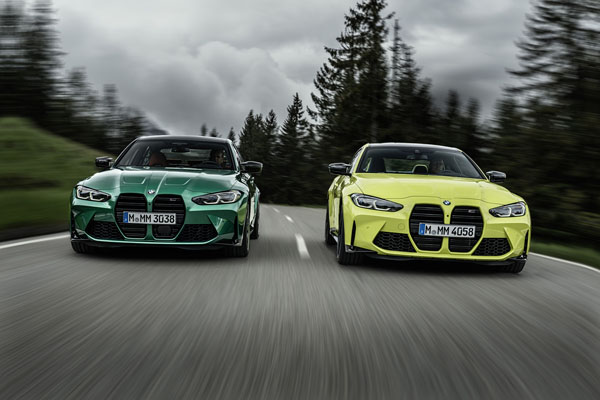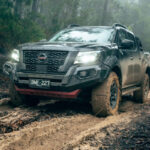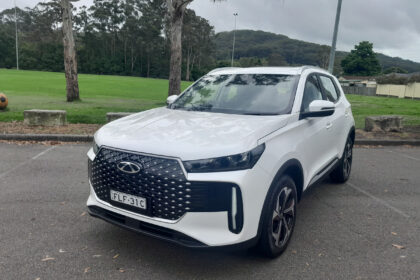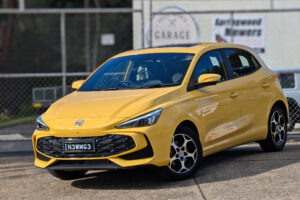
BMW M3 and M4 will arrive in Australia for local deliveries in the first quarter of 2021. The first pictures have created huge controversy, with the Dislikes leading the Likes by a big margin.
My opinion? Recent BMW models have featured a grille that’s become harder and harder to distinguish from other cars – these new models have changed all that in a big way – I love it!
The M3 and M4 are both powered by a six-cylinder in-line engine with BMW M TwinPower Turbo in two states of tune depending on the transmission offering.
One has 353kW and 550Nm, for a zero to one hundred time of just 4.2 seconds. The M3 and M4 Competition lift the outputs to 375kW and 650Nm and get to 100km/h even quicker at 3.9 seconds.
Another blast from the past is a six-speed manual gearbox – I love it!
All will have rear-wheel-drive initially, before the M3 and M4 Competition debut later next year with the BMW M xDrive system.
The power unit in the new BMW M3 and M4 has peak torque of 550Nm all the way from 2650 to 6130rpm. Maximum power of 353kW is available at 6250rpm.
The engine fitted to the Competition 650Nm between 2750 and 5500rpm. Maximum output of 375kW is developed at 6250rpm, with the engine’s redline arriving at 7200rpm.
New BMW M3 Sedan and new BMW M4 Coupé require just 4.1 seconds to power from 0 to 100 km/h while 0 to 200km/h takes 13.7 seconds. The Competition models accelerate from 0 to 100 km/h in 3.9 seconds and from 0 to 200km/h in 12.5 seconds
The manual gearbox features the Gear Shift Assistant, which uses engagement speed control to ensure slip-free operation when downshifting under braking into corners. Hmm, not sure I love this, it should be left to the driver to do the rev matching.
However, the driver has a fair bit of control over the eight-speed M Steptronic automatic. In the Competition models it enables fully automatic gear changes, or manual shifts by way of the M-specific selector lever or shift paddles on the steering wheel.
For the first time in the BMW M3 and M4, customers will be able to specify an all-wheel-drive system as an alternative to traditional rear-wheel-drive. The M xDrive system has a rear-wheel bias and links up with the Active M Differential at the rear axle.
The driver can access the Setup menu to choose between 4WD and 4WD Sport modes, the latter directing a greater proportion of the engine’s torque to the rear wheels.
BMW won’t offer the M xDrive system on the M3 and M4 Competition until late 2021.
Forged M light-alloy wheels, 19-inch at the front and 20-inch at the rear. Tyres are 275/35 ZR19 at the front and 285/30 ZR20 at the rear.
The sedan and coupé have a roof made from carbon-fibre-reinforced plastic (CFRP) with aerodynamically optimised fins, a rear spoiler and the two pairs of large t tailpipes.
A steel roof with integral glass tilt/sliding sunroof is available as a no-cost option for both models as an alternative to the standard carbon-fibre version.
Electrically adjustable M sport seats and fine-grain Merino leather trim have seat ventilation.
A highlight of the options list are M Carbon bucket seats with a structure-based design, which combine racing functionality with a lightweight construction and sumptuous workmanship. They have integral head restraints which can be dismantled for track driving. Multi-point racing seat belts can be used in these seats.
M Drive Professional has been conceived specifically for track driving. It includes M Traction Control, which allows the integrated wheel slip limitation function of the DSC system to be adjusted (through 10 stages) to the driver’s personal preferences and needs.
Both Competition models come standard with Driving Assistant Professional including Steering and Lane Control Assistant, Active Cruise Control, Cross Traffic Warning for front and rear, Lane Departure Warning and Lane Change Warning.
Standard equipment include a 16-speaker Harman Kardon surround sound system, the comfort Access System for keyless entry, three-zone automatic climate control and LED interior lighting including ambient lighting.
Updated wireless smartphone integration enables the use of both Apple CarPlay and Android Auto via the car’s operating system.
We are very much looking forward to these hot new BMW models reaching us in Australia and will arrange test drives, then bring our thoughts to you.
BMW M3 AND M4 SPARK HUGE CONTROVERSY
By EWAN KENNEDY, Marque Motoring
CAPTION: Huge vertical grille of the new BMW sports models screams out for attention.
BODY COPY
BMW M3 and M4 will arrive in Australia for local deliveries in the first quarter of 2021. The first pictures have created huge controversy, with the Dislikes leading the Likes by a big margin.
My opinion? Recent BMW models have featured a grille that’s become harder and harder to distinguish from other cars – these new models have changed all that in a big way – I love it!
The M3 and M4 are both powered by a six-cylinder in-line engine with BMW M TwinPower Turbo in two states of tune depending on the transmission offering.
One has 353kW and 550Nm, for a zero to one hundred time of just 4.2 seconds. The M3 and M4 Competition lift the outputs to 375kW and 650Nm and get to 100km/h even quicker at 3.9 seconds.
Another blast from the past is a six-speed manual gearbox – I love it!
All will have rear-wheel-drive initially, before the M3 and M4 Competition debut later next year with the BMW M xDrive system.
The power unit in the new BMW M3 and M4 has peak torque of 550Nm all the way from 2650 to 6130rpm. Maximum power of 353kW is available at 6250rpm.
The engine fitted to the Competition 650Nm between 2750 and 5500rpm. Maximum output of 375kW is developed at 6250rpm, with the engine’s redline arriving at 7200rpm.
New BMW M3 Sedan and new BMW M4 Coupé require just 4.1 seconds to power from 0 to 100 km/h while 0 to 200km/h takes 13.7 seconds. The Competition models accelerate from 0 to 100 km/h in 3.9 seconds and from 0 to 200km/h in 12.5 seconds
The manual gearbox features the Gear Shift Assistant, which uses engagement speed control to ensure slip-free operation when downshifting under braking into corners. Hmm, not sure I love this, it should be left to the driver to do the rev matching.
However, the driver has a fair bit of control over the eight-speed M Steptronic automatic. In the Competition models it enables fully automatic gear changes, or manual shifts by way of the M-specific selector lever or shift paddles on the steering wheel.
For the first time in the BMW M3 and M4, customers will be able to specify an all-wheel-drive system as an alternative to traditional rear-wheel-drive. The M xDrive system has a rear-wheel bias and links up with the Active M Differential at the rear axle.
The driver can access the Setup menu to choose between 4WD and 4WD Sport modes, the latter directing a greater proportion of the engine’s torque to the rear wheels.
BMW won’t offer the M xDrive system on the M3 and M4 Competition until late 2021.
Forged M light-alloy wheels, 19-inch at the front and 20-inch at the rear. Tyres are 275/35 ZR19 at the front and 285/30 ZR20 at the rear.
The sedan and coupé have a roof made from carbon-fibre-reinforced plastic (CFRP) with aerodynamically optimised fins, a rear spoiler and the two pairs of large t tailpipes.
A steel roof with integral glass tilt/sliding sunroof is available as a no-cost option for both models as an alternative to the standard carbon-fibre version.
Electrically adjustable M sport seats and fine-grain Merino leather trim have seat ventilation.
A highlight of the options list are M Carbon bucket seats with a structure-based design, which combine racing functionality with a lightweight construction and sumptuous workmanship. They have integral head restraints which can be dismantled for track driving. Multi-point racing seat belts can be used in these seats.
M Drive Professional has been conceived specifically for track driving. It includes M Traction Control, which allows the integrated wheel slip limitation function of the DSC system to be adjusted (through 10 stages) to the driver’s personal preferences and needs.
Both Competition models come standard with Driving Assistant Professional including Steering and Lane Control Assistant, Active Cruise Control, Cross Traffic Warning for front and rear, Lane Departure Warning and Lane Change Warning.
Standard equipment include a 16-speaker Harman Kardon surround sound system, the comfort Access System for keyless entry, three-zone automatic climate control and LED interior lighting including ambient lighting.
Updated wireless smartphone integration enables the use of both Apple CarPlay and Android Auto via the car’s operating system.
We are very much looking forward to these hot new BMW models reaching us in Australia and will arrange test drives, then bring our thoughts to you.









